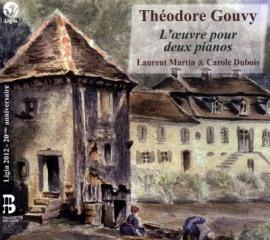Gouvy - Works for Two Pianos (2012)
Gouvy - Works for Two Pianos (2012)

Sonate pour deux pianos en ré mineur, Op.66 22:34 1. I. Largo maestoso - Allegro 2. II. Adagio cantabile 3. III. Allegro vivo 4. Scherzo, Op.60 5:38 5. Lilli Bulléro, variations pour deux pianos sur un air anglais, Op.62 11:35 6. Marche pour deux pianos, Op.63 6:58 Fantaisie pour deux pianos, Op.69 19:35 7. I. Grave - Allegro molto moderato 8. II. Adagio 9. III. Alla breve Divertissement pour deux pianos, Op.78 12:49 10. I. Andante con moto 11. II. Lento - Allegro vivace Laurent Martin & Carole Dubois - pianos
Gouvy composed a series of two-piano compositions between 1870 and 1873, while living occasionally on the estate of his older brother’s widow. She was a fine pianist, and as the composer was one as well, these two piano works came into being both for private enjoyment and performance at gatherings. A diplomatic soul, Gouvy solved the issue of primary and secondary parts by making the two largely equal, passing the lead and more difficult material back and forth between both players.
From the frowning, pomposo introduction to the Sonata’s first movement—which turns out to be the first thematic group in what is an ingenious hybrid rondo-sonata form—to the light-hearted Scherzo with its hint of a musette, these works demonstrate the expressive range of the composer. The material is usually in two or three parts, and occasionally in four, which with its increased sonority over the solo piano gives each piece a symphonic feel. It helps that Gouvy only engages in homophonic chords for variety’s sake or to make a point, as he does when he transforms the first statement of the jig Lillibullero (published originally in 1661 with the subtitle, “An Antidote Against Melancholy”) into a slow, sweetly majestic hymn. Elsewhere he is inclined to trade foreshortened thematic and rhythmic motifs, to ornament in accompaniment, and to investigate the harmonic possibilities of his themes through cross-references and bridges into far-reaching keys. Two-piano music was not that rare in France, with both Saint-Saëns and Bizet making distinguished contributions. To these Gouvy’s music on this disc can be added. Freed from the requirements of conventional symphonic form and general audience expectations, he could indulge his fancy and imagination to its fullest.
Larent Martin and Carole Dubois argue persuasively with their hands for this music. Of moderate difficulty, they encounter no technical hurdles, and their performances offer a mix of precision, clear articulation, and color. I might want a lighter touch in some of the more tongue-in-cheek passages of the Marche that recall Offenbach, but they never lack for energy; and they play the music as one, with that complete unity that only time and much practice can bestow on a two-piano partnership.
There’s only one small cloud on the horizon: Ligia’s good liner notes, complete with analysis presented on musical staves, are only offered in French. Ah, well. C’est la vie . Throw in full, forward sound, with a rich depth and bright, fully integrated top, and you have a truly pleasant surprise in store for fans of this composer. --- Barry Brenesal, FANFARE, classicalmjourney.blogspot.com
download (mp3 @320 kbs):
yandex mediafire ulozto gett bay files








